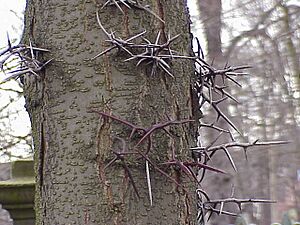Chinese honey locust facts for kids
Quick facts for kids Chinese honey locust |
|
|---|---|
 |
|
| Gleditsia sinensis trunk with thorns | |
| Scientific classification | |
| Genus: |
Gleditsia
|
| Species: |
sinensis
|
Gleditsia sinensis, also known as the Chinese honey locust or soap bean tree, is a special kind of flowering plant. It originally comes from Asia. In China, people often call it zào jiá (皂荚). This tree is known for its unique look and its many uses, especially in traditional medicine.
Contents
About the Chinese Honey Locust
The Chinese honey locust is a tall tree that can grow up to 30 meters high. That's about as tall as a 10-story building!
Tree Features
- Thorns: One of the most noticeable things about this tree is its thorns. They are often branched and can be quite long, sometimes up to 16 centimeters. These thorns are strong and cone-shaped.
- Leaves: The leaves of the Chinese honey locust are made up of many smaller leaflets, arranged like a feather.
- Flowers: The tree produces yellowish-white flowers. Some flowers are male, and some have both male and female parts. They are quite small, usually less than 1.5 centimeters wide. Each flower has four petals and four sepals.
What's in a Name?
The name Gleditsia sinensis tells us a bit about the tree. Sinensis means "from China."
Chinese Name
In China, the tree is commonly called zào jiá. This name means "soap pod" or "soap bean." This is because parts of the tree were traditionally used like soap.
English Names
Besides Chinese honey locust, you might also hear it called:
- Chinese honeylocust
- Soap bean
- Soap pod
How Plants Are Grouped (Taxonomy)
Just like animals, plants are put into groups based on how they are related. This is called taxonomy.
Family Tree
The Chinese honey locust is one of 14 different types of trees in the Gleditsia group. This group belongs to the Caesalpinioideae subfamily, which is part of the larger legume family. The legume family includes many plants like peas, beans, and peanuts.
Closest Relatives
Among all the Gleditsia species, Gleditsia caspica is the closest relative to the Chinese honey locust. This means they share a lot of common features and a similar history.
Traditional Uses
For thousands of years, the Chinese honey locust has been an important plant in traditional Chinese medicine. It's even considered one of the "50 fundamental herbs" used in this ancient practice.
Natural Cleaner
People in China have used Gleditsia sinensis as a detergent (a cleaning agent) for at least 2000 years. Imagine using a tree to wash things!
Medicinal Uses
The thorns of the Chinese honey locust are also used as a medicinal herb in China and Korea. They have been used in traditional medicine to help with various inflammatory conditions, such as swelling and skin problems.

